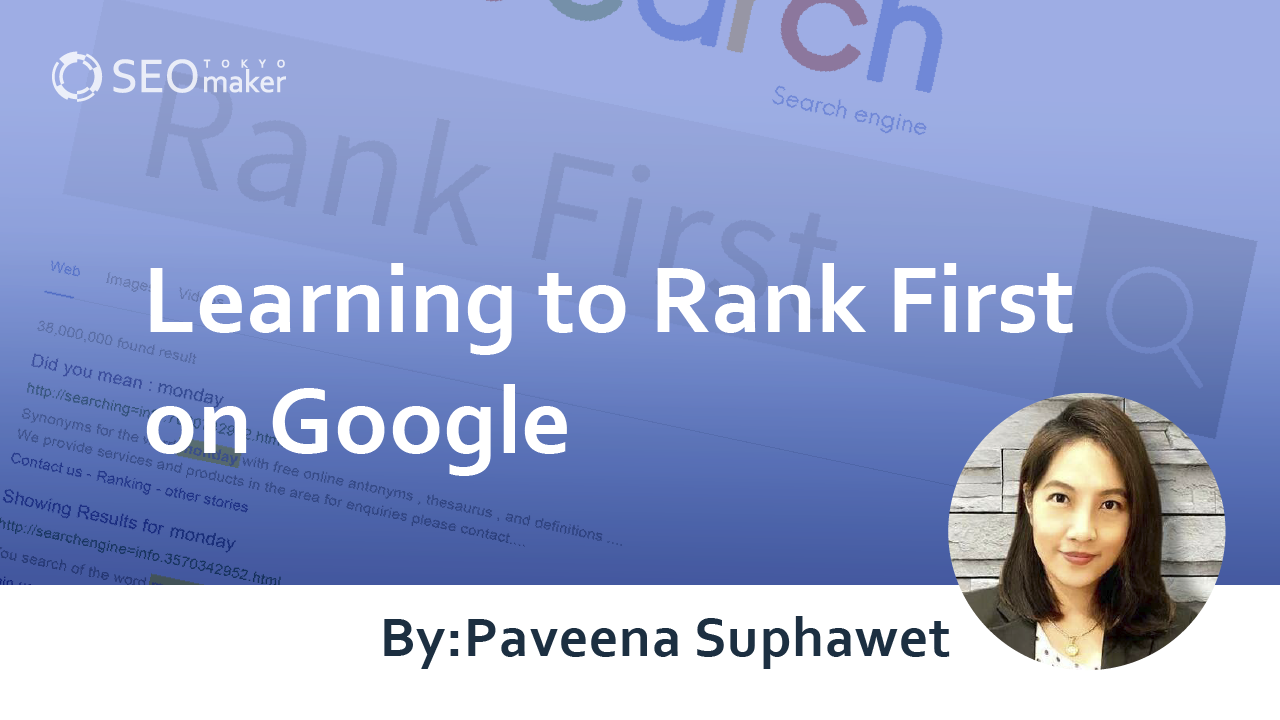Learning to Rank First on Google from an SEO Consultant [For Intermediate to Advanced Web Marketers]
contents
- 1 What is SEO measures?
- 2 To Succeed in SEO
- 2.1 Thinking about SEO Measures from Positioning and User Behavior
- 2.2 Considering SEO Measures from an Overview
- 2.3 Thinking about SEO Measures from Queries and User Demographics
- 2.4 Considering SEO Measures from Conversions
- 2.5 Reverse-Engineering Strategy for CV Acquisition
- 2.6 Considering Omnichannel Strategy and SEO Measures
- 3 Considering SEO Measures from Search Engine Algorithms
- 4 Considering SEO Measures from Content Evaluation Criteria
- 5 Overall SEO Picture
- 6 Considering the Future of SEO Measures
- 7 Summary

Web traffic acquisition through SEO has become a core component of marketing strategies . The author believes that an omnichannel strategy, which combines online and offline measures, is important in both BtoB and BtoC marketing .
In an omnichannel strategy, SEO is central. Ideally, users are directed to the website from both online and offline sources, leading to conversions .
Positioning SEO at the heart of all marketing measures and developing strategies around it can start a cycle of increasing traffic and sales.
In this article, the author, an SEO consultant and business owner, will explain the thought process and efforts that support the strategy deployment of our company, which has continued to increase sales annually. Marketers and marketing companies may find this information useful. It is hoped that enhancing the literacy of the entire web marketing industry will contribute to society.
What is SEO measures?
When discussing SEO strategies, this refers to the overall measures taken to achieve higher rankings in SEO. Previously, the focus might have been on targeting high-search-volume keywords and long-tail SEO , which targets middle or compound keywords with lower search volumes These strategies begin with keyword selection and involve specific tactics such as content SEO and technical SEO .
As of March 2023, SEO strategies are becoming insufficient on their own. This is due to the evolution of Google’s algorithms and changes in the customer journey leading to purchases. The concept of customer experience value marketing has become increasingly important in SEO. This marks the shift from SEO to SXO (Search Experience Optimization). (As you continue reading, you will understand what this means.)
Moreover, with various search results (SERPs) increasing zero-click searches , it’s not enough for a page to simply match a search query . To catch the user’s attention, it is necessary to differentiate from competitors through featured snippets and rich results , and to adapt to the chemical reaction of search forms with Bard, which incorporates Google’s AI chat, LaMDA , to be implemented in future Google searches.
The author considers all these measures as part of SEO (Search Engine Optimization). Additionally, addressing SXO (Search Experience Optimization) is crucial, including UI/UX and content creation that aligns with search intent.
While technical SEO focuses on algorithms, content SEO aligns with Google’s content evaluation metrics (Page Quality, Needs Met, EEAT, YMYL, Core Web Vitals ) as part of SXO measures.
If this information is overwhelming, consider reading to the end and then revisiting this section for a deeper understanding.
To Succeed in SEO
Success in SEO means achieving top rankings (within the first page) for various search queries to increase the number of sessions to your site. While aiming for top rankings with long-tail SEO for middle and small words, the ultimate goal is to also achieve first-page rankings for big keywords.
Achieving top rankings through long-tail SEO is possible with content SEO. Even without high SEO technical skills, maintaining and providing a large quantity of quality content that meets Google’s content evaluation criteria increases the likelihood of success.
However, without achieving top rankings for big keywords, you will continue to struggle in industry competition. The determination to break into the first page for big keywords becomes a strong motivation to enhance your search ranking position, as it’s seen as the only way to survive in your industry.
With strong motivation and ongoing SEO efforts, the domain power of the site being optimized grows alongside the site’s growth. As the domain power strengthens, visibility in search results beyond standard listings, such as featured snippets and rich results, becomes possible.
This means that by continuously working on big keyword strategies and strengthening your domain, implementing structured data for featured snippets and rich results makes it easier for these elements to appear.
In the near future, without SEO measures that enable visibility across various SERPs, survival will become challenging. Therefore, such efforts are necessary for SEO success.
Now, to ensure SEO success, I would like to explain important concepts divided into sections, supplementing the previously mentioned points.
1. Considering SEO strategies from positioning and user behavior.
2. Thinking about SEO strategies from a comprehensive perspective.
3. Formulating SEO strategies based on queries and user demographics.
4. Developing SEO strategies from conversion rates.
5. Considering omnichannel strategies and SEO.
6. Planning SEO strategies based on the characteristics of search algorithms.
7. Formulating SEO strategies from content evaluation metrics.
Thinking about SEO Measures from Positioning and User Behavior
In the realm of digital marketing, SEO stands at the core of web marketing.
As SEO is one of the strategies within marketing, it’s essential to always oversee the entire marketing spectrum and progress with measures while confirming positioning within:
Marketing > Digital Marketing > Web Marketing > SEO
Confirming the positioning in marketing and understanding the movements of target users leads to success.
Customer Journey in Web Acquisition
The purchasing behavior model essential for SEO is AISCEAS . This model helps understand at which phase of the customer journey a user is when they search. After searching, users seek a satisfying search experience. Without optimizing for Search Experience Optimization (SXO) , users will quickly leave.
We have now reviewed the starting points (dot points) of SEO within the overall marketing strategy and the user behavior’s customer journey.
By understanding the overall flow, we make these starting points the basis for thinking about SEO and other measures (online and offline strategies).
Considering SEO Measures from an Overview
To consider SEO measures from an overview, as repeatedly mentioned, we output the positioning based on the overall web marketing strategy. At this time, we comprehensively understand the phases of lead acquisition (lead generation), customer nurturing (lead nurturing) , and order taking (lead qualification), along with the customer journey and web acquisition strategies.
It is crucial to always look at the overall picture and then work on SEO measures. This perspective becomes a starting point to break through any barriers encountered in SEO efforts.
It also leads to the expression of various good ideas for SEO measures. Approaches and thoughts for successful SEO require a variety of certainties, phases, and perspectives. For now, we will keep the understanding of considered SEO measures to this level and move on.
Thinking about SEO Measures from Queries and User Demographics
Once the customer journey of user behavior is understood, we then categorize users into potential, semi-potential, and explicit layers.
We think about lead generation from these three prospect layers. It becomes clear that the SEO measures to be taken differ depending on the phase of the user’s prospect. Search queries can also be categorized into three types according to the user’s prospect layer.
1. Navigation queries
2. Information queries
3. Transaction queries
Navigation queries include brand names, product names, or well-known keywords. Transaction queries are more specific, leading to concrete actions such as purchasing a product or applying for a service, filled with the desire to buy. Information queries are used with “information “gathering” in mind.
When illustrated, it is clear that the target prospect layer changes depending on the search query of the chosen keywords. Understanding which target your acquisition strategies hit is crucial for devising an effective SEO strategy.
Considering SEO Measures from Conversions
Success in SEO results in increased sessions to the site. However, even if SEO success leads to more site visitors, without conversions such as inquiries or orders, it does not contribute to revenue growth. After all, one of the strategies to increase conversions is to implement SEO measures, making CV (Conversion Volume) a key performance indicator ( KPI ) and focusing on SEO strategies to achieve conversions.
Therefore, a reverse-engineering strategy for acquiring CVs is necessary.
To increase the expected value of CV acquisition, precise keyword selection and content SEO aligned with search intent are essential, in addition to Conversion Rate Optimization (CRO) measures . CRO measures aim to increase the conversion rate leading to conversions.
Reverse-Engineering Strategy for CV Acquisition
When considering CV acquisition, it becomes apparent that merely focusing on improving SEO rankings can lead to leads but also quick site abandonment. This realization prompts the need for CRO measures to effectively lead visitors to conversions.
CRO measures primarily involve improving the UI (User Interface) and UX (User Experience) to prevent users from leaving. Specific measures include optimizing inquiry forms ( EFO) and implementing Call to Action (CTA) strategies to facilitate easy contact.
Considering Omnichannel Strategy and SEO Measures
In BtoB lead generation, an omnichannel strategy combining online and offline measures is effective. Omnichannel refers to integrating all touchpoints and sales channels between a company and its customers to approach customers comprehensively.
After exploring various SEO positioning, we now confirm the SEO positioning from the perspective of both online and offline acquisition measures.
Next, we examine the omnichannel approach and the customer journey.
The customer journey begins with online measures and intersects with offline measures, leading to a purchase. The “moments of truth,” a marketing term, are the moments when customers take action. It is evident that there are moments of truth during online searches and the decision to visit a store. After passing through two moments of truth, experiencing both information and real-life experiences, users move towards making a purchase.
To pass the moments of truth test, SEO measures must successfully help users pass the information acquisition test and effectively guide them to a real-life experience, requiring success in SXO measures as well.
In this manner, we continue to develop our SEO and SXO measures, considering an alternative perspective as part of the omnichannel strategy.
It can be seen from the diagram that the focus is on implementing both offline and online measures centered around sites undergoing SEO optimization. The idea is to aggregate information on the site and control both online and offline measures from the site.
Considering SEO Measures from Search Engine Algorithms
Understanding SEO measures from the perspective of search engine algorithms deepens with the analogy of Maslow’s hierarchy of five human needs .
Maslow’s hierarchy posits that humans have five levels of needs, a theory in psychology indicating that human needs manifest in behavior. From this perspective, Maslow’s hierarchy can be applied to business. In marketing, understanding human needs and behaviors is crucial.
Now, let’s apply Maslow’s hierarchy to SEO.
Levels of Maslow’s Hierarchy
1.Physiological needs
2.Safety needs
3. Social needs
4.Esteem needs
5. Self-actualization needs
By classifying these needs, we can map them to the hierarchy of SEO needs.
The Five Stages of SEO Needs
1. Crawl Accessibility (it all starts with being crawlable)
2. Content Quality (it begins with having the content users are searching for)
3. Keyword Research and Optimization (must match search queries to reach users)
4. Link Acquisition (earning links from others to improve evaluation)
5. Improvements in UX, CRO, etc. (further improvements for greater success)
Thus, a strong foundation for SEO starts with ensuring crawl accessibility and progresses stepwise from there. Understanding Google’s priority for SEO needs helps in determining the steps for SEO measures.
Considering SEO Measures from Content Evaluation Criteria
There are content evaluation criteria listed in Google’s guidelines that are not part of the SEO algorithm. In December last year, the EAT evaluation criteria were replaced by EEAT , with E (Experience) being added. This means content based on experience has been added to the evaluation criteria as trusted content. From this, we can realize that content, users, and searches are all prioritizing experience.
Google’s Evaluation Criteria
- Page quality rating
- Needs Met rating
- EEAT
- YMYL
- Core Web Vitals
Essential Google Algorithm Updates (Four updates to keep in mind)
- Core Algorithm Update
- Panda Update
- Penguin Update
- BERT Update
Evaluation criteria and Google’s differ algorithm. Algorithm updates occur regularly and significantly impact rankings. Evaluation criteria provide a direction for content to achieve higher SEO rankings.
Overall SEO Picture
We have looked at SEO measures from various perspectives. Each perspective is important, and only by taking a comprehensive approach to SEO measures can we truly understand success. Let’s now look at the overall picture of SEO.
Until now, we have viewed SEO from a broad overview perspective. For the first time here, we are looking at SEO measures for a single site.
In doing so,
1. Keyword selection allows for a deep understanding from the thought process learned when “Thinking about SEO Measures from Queries and User Demographics.” 2. Internal measures set priorities based on the thought process learned when “Considering SEO Measures from Search Engine Algorithms.”
3. Content creation brings up ideas for creating content from “Considering SEO Measures from Content Evaluation Criteria.” 4. SXO measures are supported by the importance of CRO learned when “Considering SEO Measures from Conversions.”
5. External measures, from all the learning so far, allow for the consideration of acquiring citations through press releases, bringing insights on prioritizing them lower.
SEO measures, seen from various certainties, provide insights that significantly change the approach and results compared to SEO measures without such insights.
Please also read this for a different perspective >> What is SEO? The Latest Guide to SEO and Complete SEO Checklist 100 for Beginners to Advanced
Considering the Future of SEO Measures
Thus far, we’ve considered SEO and its measures from various perspectives. Let’s entertain the thought that SEO might become obsolete.
The introduction of ChatGPT by OpenAI could pose a serious threat to Google’s primary search engine business, prompting Google to consider introducing a conversational AI named Bard into search.
If conversational AI becomes the norm in the future and users no longer browse search results from a search box, SEO could, in effect, become extinct. However, it seems that Google is considering using conversational AI alongside SEO and advertising.
The image above is a citation from Google’s official blog. On the right side, you can see someone interacting with the conversational AI named Bard. Upon closer inspection, you can see that organic SEO search results appear below the response to the question. From this , we can infer that SEO will remain even after Bard is implemented.
However, since nothing is certain, thinking about SEO measures from a broad marketing perspective as we have learned can help us quickly find the next move even if SEO disappears. After all, SEO is just one of the means for web acquisition.
Summary
How was the “Guide to Learning SEO Measures from Seven Thoughts of an SEO Consultant”? This time, we didn’t introduce detailed SEO techniques but shared the author’s thoughts on approaching SEO measures. SEO techniques can be acquired through both macro and micro- level efforts. Web marketers are encouraged to refer to this. For detailed SEO techniques, please refer to “What is SEO? The Latest Guide to SEO and Complete SEO Checklist 100 for Beginners to Advanced.” We also host networking events for those with high SEO literacy. If you’re interested, please contact us through the inquiry form.










![What is a Description? Explaining the Meaning, Writing Style, and Changing Word Count – [2023 Edition]](https://www.switchitmaker2.com/en/wp-content/uploads/2024/09/what-is-description.webp)










